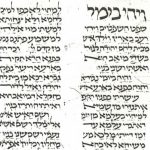Follow this link for the full schedule and abstracts for Targum papers to be delivered at the 2022 IOTS/SBL IM in Salzburg this summer.
Category Archives: News
2022 IOTS Conference Call for Papers
Call for Papers
It is a pleasure for the executive committee of the International Organization for Targumic Studies (IOTS) to invite you to the IOTS conference, connected to the international SBL conference on 17-21 July 2022 in Salzburg. The conference will accept proposals on the following topics:
- Targums of the Tora
- Targum and Qumran
- Targum Studies: Past and Present
but papers on other related topics are also welcome. Abstracts of no more than 300 words can be sent to Eveline van Staalduine-Sulman (e.van.staalduine-sulman@vu.nl) before 1 March 2022.
Canceled: 2020 IOTS Conference Call for Papers
UPDATE on canceled conference::
Dear IOTS members and conference participants,
Contrary to what we previously hoped for, the measures to stop the spread of the coronavirus have become increasingly strict, in the Netherlands as well as in other countries around the world. As we don’t know how long these restrictions will last, we have come to the conclusion that, much to our regret, we must cancel the IOTS conference scheduled for July this year. We will hopefully meet each other at the IOTS / IOSOT meeting in Zurich in 2022. Stay healthy!
Kind regards,
Eveline van Staalduine-Sulman
Margaretha Folmer
It is a pleasure for the executive committee of the International Organization for Targumic Studies (IOTS) to invite you to the IOTS conference on 6-8 July 2020 at Vrije Universiteit, Amsterdam. The conference will know at least three topics,
- Targums of the Tora
- Targum and Peshitta
- Targum and Qumran
but papers on other related topics are also welcome. Abstracts of no more than 300 words can be sent to Eveline van Staalduine-Sulman (e.van.staalduine-sulman@vu.nl) before 1 March 2020.

Derek R. G. Beattie, d. 31 August 2019. A scholar who will be greatly missed.
From Christian Brady:
This past week I received word from Paul Flesher that Derek Beattie died on Saturday, 31 August at his home in Chandler’s Ford, Hampshire. He was 73 years old. His son has said that plans for the funeral are still in process, but it is likely to be on 13th September.
One of my great regrets now will always be that I was unable to meet Derek in person. We corresponded quite a bit while I was working on Targum Ruth and Derek was incredibly gracious to me. The Book of Ruth and its rabbinic interpretation, especially the Targum, was a subject he knew more about than perhaps any person living. It began with his doctoral work (see Jewish Exegesis of the Book of Ruth) and continued right until the end. In the last few years I know that the had been hoping to complete his commentary on Targum Ruth.
Derek always kindly responded to my emails, offering corrections and suggestions on my work, and was even willing to make his critical edition of Targum Ruth available to me for publication. (In the end I simply provided a transcription of the base manuscript, but his work was often referenced in my volume.) I am so grateful to have corresponded with him and only wish I had truly gotten to know him.
His faculty page at Queen’s University Belfast, where he was a longtime faculty member, has this bio.
Derek read Hebrew and Semitic (formerly Oriental) Languages at Trinity College, Dublin, in the heyday of Jacob Weingreen’s Honor School, then migrated to St Andrews where he took his PhD under the supervision of William McKane. After a brief period as a lecturer in the University of Aberdeen he was appointed to a lectureship in Semitic Studies at Queen’s University Belfast in 1973 and was head of the Department of Semitic Studies from 1985 until its absorption in the school of Greek, Roman & Semitic [subsequently Byzantine] Studies.
As a very meagre memento, below is the bibliography that I have of Derek’s work. I am certain it is incomplete and welcome additions from readers.
Bibliography

Beattie, D R G. “Kethibh and Qere in Ruth IV 5.” Vetus Testamentum21, no. 4 (1971): 490-494.
Beattie, D R G. “The Book of Ruth as Evidence for Israelite Legal Practice.” Vetus Testamentum24, no. 3 (1974): 251-267.
Beattie, D R G, Jewish Exegesis of the Book of Ruth.Sheffield: Sheffield University, 1977.
Beattie, D R G. “Midrashic Gloss in Ruth 2:7.” Zeitschrift fur die alttestamentliche Wissenschaft89 (1977): 122-124.
Beattie, D R G. “Redemption in Ruth, and Related Matters: A Response to Jack M. Sasson.” Journal for the Study of the Old Testament5 (1978): 65-68.
Beattie, D R G. “Ruth III.” Journal for the Study of the Old Testament5, no. 39-48 (1978): 39-48.
Beattie, D R G. “The Targum of Ruth: A Sectarian Composition?”. Journal of Jewish Studies36, no. 2 (1985): 222-229.
Beattie, D R G. “The Targum of Ruth – 18 Years On.” Hermathena (1985): 57-61.
Beattie, D R G. “Towards dating the Targum of Ruth,” in Word in Season. Sheffield, JSOT Press, 1986, 205-221.
Beattie, D R G. “Ancient Elements in the Targum to Ruth,” Pages 159-165 in Proceedings of the Ninth World Congress of Jewish Studies, Jerusalem, August 4-12, 1985. Jerusalem: World Union of Jewish Studies, 1986.
Beattie, D R G. “Ruth 2:7 and midrash.” Zeitschrift für die alttestamentliche Wissenschaft, 99 (1987): 22-423.
Beattie, D R G. “The Yemenite Tradition of Targum Ruth.” Journal of Jewish Studies41, no. 1 (1990): 49-55.
Beattie, D R G. “The Textual Tradition of Targum Ruth,” in Aramaic Bible(Sheffield, JSOT Pr), 1994, 340-348.
Beattie, D R G, The Targum of Ruth.Vol. 19. Collegeville: Liturgical, 1994.
Beattie, D R G. “Baldrick and Blackadder revive an ancient exegetical question relating to Ruth.” Belfast Byzantine Texts and Translations9 (2000).
Beattie, D R G. “The Targum Ruth: A Preliminary Edition,” Pages 231-290 in Targum and Scripture: Studies in Aramaic Translations and Interpretations in Memory of Ernest G. Clarke. Edited by Paul VM Flesher. Leiden: Brill, 2002.
Beattie, D R G and P R Davies. “What Does Hebrew Mean?”. Journal of Semitic Studies56, no. 1 (2011): 71-83.
Beattie, D R G and M J McNamara, The Aramaic Bible: Targums in their Historical Context.Sheffield, UK: Sheffield Academic Press / JSOT Press, 1994.
Valmadonna Collection Purchased by the National Library of Israel – Targum MS in Museum of the Bible
This is very good news! It appears the entire collection has been purchased by the Israeli National Library. Several years ago Sotheby’s was exhibiting and the family seeking to sell this incredibly important collection. It is particularly important for Targum scholars because it includes Valmadonna 1 (formerly Sassoon 282). UPDATE: That is NOT the case. Valmadonna 1 was purchased by the Museum of the Bible: Codex Valmadonna 1. The Sotheby’s catalogue described the manuscript as follows:
The jewel in the Valmadonna Library’s crown is one of the most important privately-owned books in the world – a Pentateuch (Hebrew Bible), written in England the summer of 1189. Known as the Codex Valmadonna I, this extraordinary book is the only dated Hebrew text in existence from medieval England, before King Edward I’s 1290 edict expelling the Jews.
It is a massive collection and many scholars were worried it would be separated and go into private collections. This should ensure access and enable new research going forward. The JC article shares a few more details about the collection and the owner, Jack Lunzer, who recently passed away.
The Valmadonna Trust Library, widely regarded as the finest private collection of Hebrew books and manuscripts in the world, was assembled by Jack Lunzer, who spent more than six decades assembling it.
The vast collection charts the spread of Hebrew printing around the world and includes 550 broadsheets and newspapers dating back as far as the 16th century.
Hailing the purchase, Oren Weinberg, director of the National Library of Israel said: “The Valmadonna Trust Library represents an historic addition to our leading collection of Jewish manuscripts, prints and books, which reflect and embody the cultures of the Jewish people around the world and across the ages.”
Mr Lunzer, who died last month at the age of 92, was born in Antwerp and made his fortune as a young man in the diamond industry in London. He named his collection after the town of Valmadonna in northern Italy, where he and his wife Ruth Zippel, had connections. In 2015 Mr Lunzer sold his 16th century Babylonian Talmud, made by the Christian printer Daniel Bomberg, for US$9.3 million (£7.5 million).
Tg Obadiah
A new translation of Targum Obadiah by Thomas Lenihan (B.A. History – California University of Pennsylvania) has been submitted and added to the site. Feel free to address any questions or suggestions on the translations directly to TL.
As a reminder, if you have your own translation of Targumic texts not represented here please feel free to submit them to Christian Brady, webmaster.
Targum.info is up and running!
It looks like all is well now and should be fully restored. I did have to use an older backup so if you find something is missing or out of date please let me know.
Please be patient! Rebuilding…
 We had a crash of the site and all of the pages other than this one are down. In fact, you cannot even get to this posts page! It only appears on the home page. The content is safe, but it will take some time to determine how to restore it to functioning order. (I believe it is a MSQL issue…any WordPress gurus want to lend a hand? Let me know!)
We had a crash of the site and all of the pages other than this one are down. In fact, you cannot even get to this posts page! It only appears on the home page. The content is safe, but it will take some time to determine how to restore it to functioning order. (I believe it is a MSQL issue…any WordPress gurus want to lend a hand? Let me know!)
Welcome Back!
After several months down we are slowly bringing the Newsletter for Targumic and Cognate Studies back! All the currently available English translations of the Targumim are back online as well as the Solger MS images of TgRuth and TgLam. Stay tuned for updates and news from the International Organization for Targum Studies.

